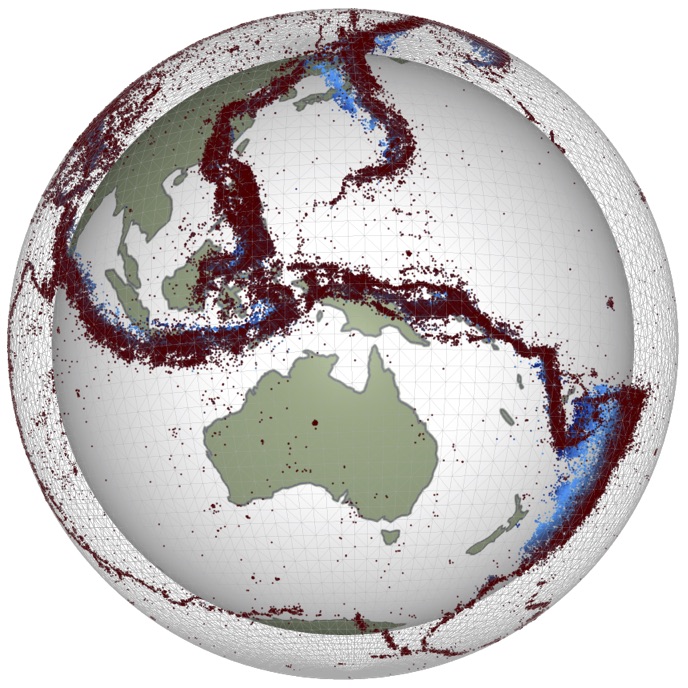Cylindrical Stokes with Coriolis term (out of plane)#
# to fix trame issue
import nest_asyncio
nest_asyncio.apply()
import petsc4py
from petsc4py import PETSc
import underworld3 as uw
import numpy as np
import sympy
expt_name = "NS_FS_flow_coriolis_disk_500_iii"
import meshio
# meshball = uw.meshes.SphericalShell(
# dim=2, radius_outer=1.0, radius_inner=0.0, cell_size=0.075, degree=1, verbose=False
# )
meshball = uw.meshing.Annulus(radiusOuter=1.0, radiusInner=0.0, cellSize=0.05, degree=1, centre=False, verbosity=True)
v_soln = uw.discretisation.MeshVariable("U", meshball, 2, degree=2)
p_soln = uw.discretisation.MeshVariable("P", meshball, 1, degree=1)
t_soln = uw.discretisation.MeshVariable("T", meshball, 1, degree=3)
r = uw.discretisation.MeshVariable("R", meshball, 1, degree=1)
v_soln_1 = uw.discretisation.MeshVariable("U_1", meshball, meshball.dim, degree=2)
vorticity = uw.discretisation.MeshVariable("omega", meshball, 1, degree=1)
swarm = uw.swarm.Swarm(mesh=meshball)
v_star = uw.swarm.SwarmVariable("Vs", swarm, meshball.dim, proxy_degree=3)
remeshed = uw.swarm.SwarmVariable("Vw", swarm, 1, dtype="int", _proxy=False)
X_0 = uw.swarm.SwarmVariable("X0", swarm, meshball.dim, _proxy=False)
swarm.populate(fill_param=4)
# Create a density structure / buoyancy force
# gravity will vary linearly from zero at the centre
# of the sphere to (say) 1 at the surface
import sympy
radius_fn = sympy.sqrt(
meshball.rvec.dot(meshball.rvec)
) # normalise by outer radius if not 1.0
unit_rvec = meshball.rvec / (1.0e-10 + radius_fn)
gravity_fn = radius_fn
# Some useful coordinate stuff
x = meshball.N.x
y = meshball.N.y
# r = sympy.sqrt(x**2+y**2)
th = sympy.atan2(y + 1.0e-5, x + 1.0e-5)
#
Rayleigh = 1.0e2
#
hw = 1000.0 / 0.075
surface_fn = sympy.exp(-(((r.fn - 1.0) / 1.0) ** 2) * hw)
orientation_wrt_z = sympy.atan2(y + 1.0e-10, x + 1.0e-10)
v_rbm_z_x = -r.fn * sympy.sin(orientation_wrt_z) * meshball.N.i
v_rbm_z_y = r.fn * sympy.cos(orientation_wrt_z) * meshball.N.j
v_rbm_z = v_rbm_z_x + v_rbm_z_y
# Create NS object
navier_stokes = uw.systems.NavierStokesSwarm(
meshball,
velocityField=v_soln,
pressureField=p_soln,
velocityStar_fn=v_star.fn,
u_degree=v_soln.degree,
p_degree=p_soln.degree,
rho=1.0,
theta=0.5,
verbose=False,
projection=True,
solver_name="navier_stokes",
)
navier_stokes.petsc_options.delValue(
"ksp_monitor"
) # We can flip the default behaviour at some point
navier_stokes._u_star_projector.petsc_options.delValue("ksp_monitor")
navier_stokes._u_star_projector.petsc_options["snes_rtol"] = 1.0e-2
navier_stokes._u_star_projector.petsc_options["snes_type"] = "newtontr"
navier_stokes._u_star_projector.smoothing = 0.0 # navier_stokes.viscosity * 1.0e-6
navier_stokes._u_star_projector.penalty = 0.0
# Constant visc
navier_stokes.rho = 1.0
navier_stokes.theta = 0.5
navier_stokes.penalty = 0.0
navier_stokes.viscosity = 1.0
# Free slip condition by penalizing radial velocity at the surface (non-linear term)
free_slip_penalty = 1.0e4 * Rayleigh * v_soln.fn.dot(unit_rvec) * unit_rvec * surface_fn
# Velocity boundary conditions
# navier_stokes.add_dirichlet_bc( (0.0, 0.0), "Upper", (0,1))
# navier_stokes.add_dirichlet_bc( (0.0, 0.0), "Centre", (0,1))
v_theta = (
navier_stokes.theta * navier_stokes.u.fn
+ (1.0 - navier_stokes.theta) * navier_stokes.u_star_fn
)
nodal_vorticity_from_v = uw.systems.Projection(meshball, vorticity)
nodal_vorticity_from_v.uw_function = sympy.vector.curl(v_soln.fn).dot(meshball.N.k)
nodal_vorticity_from_v.smoothing = 1.0e-3
t_init = sympy.cos(3 * th)
with meshball.access(r):
r.data[:, 0] = uw.function.evaluate(
sympy.sqrt(x**2 + y**2), meshball.data
) # cf radius_fn which is 0->1
# Write density into a variable for saving
with meshball.access(t_soln):
t_soln.data[:, 0] = uw.function.evaluate(t_init, t_soln.coords)
navier_stokes.bodyforce = Rayleigh * unit_rvec * t_init # minus * minus
navier_stokes.bodyforce -= free_slip_penalty # + solid_body_penalty
v_proj = navier_stokes._u_star_projector.u
free_slip_penalty_p = 100 * v_proj.fn.dot(unit_rvec) * unit_rvec * surface_fn
navier_stokes._u_star_projector.F0 = free_slip_penalty_p # + solid_body_penalty_p)
navier_stokes.solve(timestep=10.0)
nodal_vorticity_from_v.solve()
with meshball.access():
v_inertial = v_soln.data.copy()
with swarm.access(v_star, remeshed, X_0):
v_star.data[...] = uw.function.evaluate(v_soln.fn, swarm.data)
X_0.data[...] = swarm.data[...]
swarm.advection(v_soln.fn, delta_t=navier_stokes.estimate_dt(), corrector=False)
# check the mesh if in a notebook / serial
def plot_V_mesh(filename):
if uw.mpi.size == 1:
import pyvista as pv
import underworld3.visualisation as vis
pvmesh = vis.mesh_to_pv_mesh(meshball)
pvmesh.point_data["T"] = vis.scalar_fn_to_pv_points(pvmesh, t_soln.sym)
pvmesh.point_data["P"] = vis.scalar_fn_to_pv_points(pvmesh, p_soln.sym)
pvmesh.point_data["Om"] = vis.scalar_fn_to_pv_points(pvmesh, vorticity.sym)
velocity_points = vis.meshVariable_to_pv_cloud(navier_stokes.u)
velocity_points.point_data["V"] = vis.vector_fn_to_pv_points(velocity_points, navier_stokes.u.sym)
pl = pv.Plotter(window_size=(1000, 750))
pl.camera.SetPosition(0.0001, 0.0001, 4.0)
# pl.add_mesh(pvmesh,'Black', 'wireframe')
pl.add_mesh(
pvmesh,
cmap="coolwarm",
edge_color="Black",
show_edges=True,
scalars="Om",
use_transparency=False,
opacity=0.5,
)
pl.add_arrows(velocity_points.points, velocity_points.point_data["V"], mag=0.03)
pl.screenshot(
filename="{}.png".format(filename),
window_size=(2560, 2560),
return_img=False,
)
pl.close()
del pl
ts = 0
swarm_loop = 5
vorticity.fn
for step in range(0, 10):
Omega_0 = 50.0 * min(ts / 10, 1.0)
Coriolis = (
2.0 * Omega_0 * navier_stokes.rho * sympy.vector.cross(meshball.N.k, v_theta)
)
navier_stokes.bodyforce = Rayleigh * unit_rvec * t_init # minus * minus
navier_stokes.bodyforce -= free_slip_penalty
navier_stokes.bodyforce -= Coriolis * (1.0 - surface_fn)
delta_t = 1.0 * navier_stokes.estimate_dt()
navier_stokes.solve(timestep=delta_t, zero_init_guess=False)
nodal_vorticity_from_v.solve()
_, z_ns, _, _, _, _, _ = meshball.stats(v_soln.fn.dot(v_rbm_z))
print("Rigid body: {}".format(z_ns))
dv_fn = v_soln.fn - v_soln_1.fn
_, _, _, _, _, _, deltaV = meshball.stats(dv_fn.dot(dv_fn))
with meshball.access(v_soln_1):
v_soln_1.data[...] = v_soln.data[...]
with swarm.access(v_star):
v_star.data[...] = (
0.5 * uw.function.evaluate(v_soln.fn, swarm.data) + 0.5 * v_star.data[...]
)
swarm.advection(v_soln.fn, delta_t=delta_t, corrector=False)
# Restore a subset of points to start
offset_idx = step % swarm_loop
with swarm.access(swarm.particle_coordinates, remeshed):
remeshed.data[...] = 0
remeshed.data[offset_idx::swarm_loop, :] = 1
swarm.data[offset_idx::swarm_loop, :] = X_0.data[offset_idx::swarm_loop, :]
# re-calculate v history for remeshed particles
# Note, they may have moved procs after the access manager closed
# so we re-index
with swarm.access(v_star, remeshed):
idx = np.where(remeshed.data == 1)[0]
v_star.data[idx] = uw.function.evaluate(v_soln.fn, swarm.data[idx])
if uw.mpi.rank == 0:
print("Timestep {}, dt {}, deltaV {}".format(ts, delta_t, deltaV))
if ts % 1 == 0:
# nodal_vorticity_from_v.solve()
plot_V_mesh(filename="output/{}_step_{}".format(expt_name, ts))
# savefile = "output/{}_ts_{}.h5".format(expt_name,step)
# meshball.save(savefile)
# v_soln.save(savefile)
# p_soln.save(savefile)
# vorticity.save(savefile)
# meshball.generate_xdmf(savefile)
navier_stokes._u_star_projector.smoothing = navier_stokes.viscosity * 1.0e-6
ts += 1
navier_stokes._p_f0
# check the mesh if in a notebook / serial
if uw.mpi.size == 1:
import pyvista as pv
import underworld3.visualisation as vis
pvmesh = vis.mesh_to_pv_mesh(meshball)
pvmesh.point_data["T"] = vis.scalar_fn_to_pv_points(pvmesh, t_soln.sym)
pvmesh.point_data["P"] = vis.scalar_fn_to_pv_points(pvmesh, p_soln.sym)
pvmesh.point_data["Om"] = vis.scalar_fn_to_pv_points(pvmesh, vorticity.sym)
velocity_points = vis.meshVariable_to_pv_cloud(navier_stokes.u)
velocity_points.point_data["V"] = vis.vector_fn_to_pv_points(velocity_points, navier_stokes.u.sym)
pl = pv.Plotter(window_size=[1000, 1000])
# pl.add_mesh(pvmesh,'Black', 'wireframe')
pl.add_mesh(
pvmesh,
cmap="coolwarm",
edge_color="Black",
show_edges=True,
scalars="Om",
use_transparency=False,
opacity=0.5,
)
pl.add_arrows(arrow_loc, arrow_length, mag=0.05)
pl.show(cpos="xy")
meshball.stats(
sympy.vector.cross(Omega, v_soln.fn).dot(sympy.vector.cross(Omega, v_soln.fn))
)
meshball.stats(v_soln.fn.dot(v_rbm_z))
meshball.stats(v_soln.fn.dot(v_soln.fn))
meshball.stats(v_soln.fn.dot(v_rbm_z))
meshball.stats((v_soln.fn + 0.015 * v_rbm_z).dot(v_rbm_z))
meshball.stats(sympy.vector.cross(Omega, v_soln.fn).dot(v_rbm_z))
sympy.vector.cross(Omega, v_soln.fn)
_, z_ns, _, _, _, _, _ = meshball.stats(v_soln.fn.dot(v_rbm_z))
print("Rigid body: {}".format(z_ns))
x_ns_

